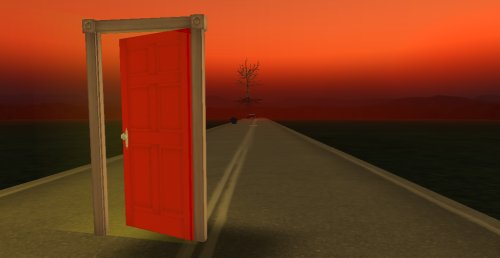February 3, 2010
by olivia
I recently spent some time wandering around The Leominster Galleries, a new project from Sigmund Leominster, of SL on SL fame. The space exists to showcase Siggy’s personal art collection, with three floors of permanent exhibits and a room for temporary shows, all floating in the air high above the Root Squared sim.

Siggy’s taste seems to be firmly rooted in the 19th century, with the work of William Adolphe Bouguereau particularly well represented:

Bouguereau is an interesting choice; a stalwart of the French Académie des Beaux-Arts, he was acclaimed a genius in his day, but his reputation declined spectacularly in the 20th century, when his work was largely viewed as technically competent, but exemplifying the worst aspects of the ossified Academic style. He was entirely eclipsed by the Impressionists, a movement he had attempted to exclude from the Salon, and which he struggled to understand. More recently reviving the popularity of Bouguereau has become somewhat of a cause célèbre among conservative art critics, who see in his work an affirmation of traditional values tragically displaced (in their view) by modernism.
I don’t know if Siggy is making a political point with his picture selection, or if he just likes the sanitised eroticism that was popular in 19th century bourgeois circles. To be fair, the collection is not entirely composed of tasteful nudes in classical tableaux – there are some tasteful nudes in faux-Arthurian tableaux too, courtesy of the Pre-Raphaelites:

a fair representation of Symbolist works:

and a smattering of Surrealism:

The visit introduced me to several works I hadn’t seen before, since, I must admit, I usually hurry through the 19th century rooms when I visit the big galleries, so it was educational to a degree, but I do wonder what value was added by hosting the exhibition in Second Life, rather than, say, posting it in a blog. I suppose one could invite one’s friends around to make it a more social experience. The exhibits might perhaps be a little more interactive, with links to information about the artists and movements, and some explanation of the curatorial philosophy. The gallery design could be a bit less clinical too, since the modern aesthetic of the plain walls and light wood floor clashes somewhat with the cluttered hanging. A few chairs wouldn’t go amiss either. These are minor criticisms though, and the Leominster Galleries are well worth checking out.
A rather different artistic experience is on offer at The Primtings Museum, where they don’t hang the pictures on the walls, but build installations that allow visitors to place themselves into some iconic images:



(I’m pretty sure that I once sat in a real-life recreation of Van Gogh’s Room at Arles, but this was in Amsterdam, so it might just have been a drug-fuelled hallucination.)
There are dozens of works on display by various virtual artists, including our old friend AM Radio, who reworked David’s The Death of Marat, above. A full catalogue can be found on the Primtings website.
Surrealist paintings provide the inspiration for a large number of pieces, but, ironically, these are perhaps the least successful works in the gallery. The dream-like quality of Surrealism seems to be lost rather than enhanced by being lifted from the canvas and transformed into rather prosaic tangible objects:

I think for these sort of pieces to work they would have to be more immersive than just three dimensional representations of the paintings presented in a box. A sim-scale re-imagining of Un Chien Andalou perhaps, with the opportunity to slice up eyeballs and pull a piano full of dead donkeys around.
My favourite work at Primtings is this replica of Damien Hirst’s The Physical Impossibility of Death in the Mind of Someone Living:

As befits conceptual art this works just as well in Second Life as it does in reality. The best part is that you can take away a free copy of the formaldehyde tank (though not the shark), and suspend yourself, or your loved ones, in it when you get home.
I did wonder a bit about the copyright status of these two galleries. I think Siggy should be all right, since the artists he features are all long dead, but Primtings might be on shakier ground if Hirst ever finds out they have been ripping him off, so you should probably take it in while you still can.
And finally – Johnny would have a fit if I mentioned Un Chien Andalou without linking to this.

















